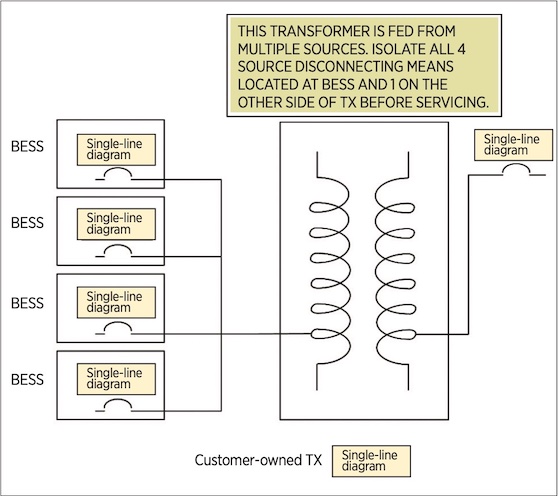
Articles
Cleantech
Features
Cleantech
Code File
Codes & Standards
Energy & Power
Energy Storage
In-Depth
Multiple power sources and transformer disconnection – Code File, Summer 2023
August 22, 2023 | By Nansy Hanna, P.Eng.

August 22, 2023 – As the installation of renewable and energy storage systems increases, related codes and standards have attempted to adapt. Transformers are traditionally unidirectional, connected to a single source and feeding a load but, in the case of battery energy storage systems (BESSs) or bi-directional EV supply equipment, the load is now also a source that can supply power in the opposite direction.
Naturally, this can create challenges in the application of some CE Code rules.
Diagram 1 shows multiple BESSs connected to a single transformer. In Charging Mode, the TX primary is connected to a supply authority system while the BESSs function as a load connected to the TX secondary circuits. This mode of operation is like a traditional connected load.

In Discharge Mode, however, the BESSs function as electric power production sources, either transferring stored energy back to the supply authority or supporting customer loads.
A BESS is capable of running in parallel with supply authority systems and, as such, we turn to Section 84 rules for the interconnection of electric power production sources, plus any applicable rules from Section 64. When a TX has a source on both sides, Rule 64-058(2) requires that each side be considered the primary and be provided with overcurrent protection.
Since both sides of the TX are considered the primary (based on the operational modes of BESSs), certain requirements in Section 26 for transformer primary disconnecting means shall apply. Rule 26-248 states “A disconnecting means shall be installed in the primary circuit of each power and distribution transformer”.
Considering a traditional transformer’s operation, some may interpret Rule 26-248’s requirement for a single primary circuit as a single disconnecting means.
However, when multiple BESSs are connected to a single TX, we end up multiple primary circuits. It is debatable whether Rule 26-248 requires a disconnecting means for each primary circuit, or a single disconnecting means for the transformer.
Meantime, Rule 64-060(6) states “Where the equipment is energized from more than one supply source, the disconnecting means shall comply with Rules 14-414 and 14-700”.
In our example, the transformer is the “equipment” that is energized from more than one supply source (other sources of voltage). Each BESS supply circuit is provided with a disconnecting means that may not be adjacent to the TX, but may be grouped in accordance with Rule 14-414(1)(b).
CE Code Rule 84-020 and ESA Bulletin 64-1 both require a disconnecting means for each power production source. It is debatable whether these two requirements—disconnecting means for each source and disconnecting means for each primary circuit—could be achieved with one device.
As we contemplate the application of these different CE Code requirements, consider the following: Does Rule 26-248 require a single disconnecting means on both sides of a TX connected to multiple production sources, such as the BESSs in Diagram 1?
Based on a literal interpretation of the Rule, the answer is Yes.
But, notwithstanding Rule 26-248 and considering Rules 64-060(6) and 14-414(1)(b), a disconnecting means located in each source circuit may be permitted and could provide an alternative to requiring a single disconnecting means, if certain conditions are met. (I will explore those conditions in my next column.)

Nansy Hanna, P.Eng., is senior director, Engineering & Regulations, at Ontario’s Electrical Safety Authority (ESA). She is also chair of the Canadian Advisory Council on Electrical Safety (CACES) and a member of the ULC Advisory Council and CSA Technical Committee on CE Code-Part I. She can be reached at nansy.hanna@electricalsafety.on.ca.
You’ll find all Back Issues of Electrical Business Magazine in our Digital Archive.
Print this page
